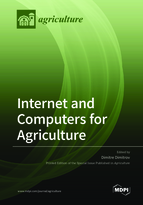Internet and Computers for Agriculture
A special issue of Agriculture (ISSN 2077-0472). This special issue belongs to the section "Digital Agriculture".
Deadline for manuscript submissions: closed (25 August 2022) | Viewed by 99044
Special Issue Editor
Interests: mathematical-process-based and machine learning modeling; ecohydrology; biogeochemistry; ecosystem productivity
Special Issues, Collections and Topics in MDPI journals
Special Issue Information
Dear Colleagues,
Given the current growth in global challenges, such as the rapidly increasing human population along with its need for sustainable and secure food production, water and natural resources management, and minimizing of GHG emissions, especially under the conditions of climate change, the need for smart agriculture practices and effective strategies is emerging as an imminent issue at a planetary scale. Agriculture 4.0 involves a large variety of mobile apps, web applications, Internet of Things (IoT) devices, drones, and robots for precision agriculture. The expansion of cloud technologies, artificial intelligence (AI), machine learning, and big data is paving the way to Agriculture 5.0. Agriculture and natural sciences are further boosting this trend with the development of leading-edge scientific models and platforms, ranging from scientific process-based modeling to data-driven machine learning modeling.
The above reflects the efforts of a growing cohort of scientists, researchers, and entrepreneurs looking for a stage to present their innovative research, software products, and digital solutions. These internet and computer applications target smart technical solutions for soil and crop diagnostics, irrigation, fertilization, monitoring, harvest estimation, sharing of best practices, and adjusting to weather and climate change, offering financial options, digital markets for producers and distributors, smart agriculture machinery, and other software-as-a-service and platform-as-a-service options for farmers and agriculture companies.
This Special Issue intends to cover the recent and current progress in all aspects of internet and computer software applications in agriculture. Thus, submissions of original articles and reviews are invited on the development of mobile apps, web applications, platforms; and smart IoT devices in precision agriculture for monitoring, cultivation, harvesting, and marketing; development of cloud technologies for agriculture; AI and machine learning solutions; applications of computer vision, drones, and sensors for field operations; diagnostics and data collection; smart agriculture machinery; big data science; scientific process-based modeling, and machine learning modeling for agriculture, agroecosystems and natural ecosystems, which can contribute to the modern agriculture practices of the future.
Dr. Dimitre Dimitrov
Special Issue Editor
Manuscript Submission Information
Manuscripts should be submitted online at www.mdpi.com by registering and logging in to this website. Once you are registered, click here to go to the submission form. Manuscripts can be submitted until the deadline. All submissions that pass pre-check are peer-reviewed. Accepted papers will be published continuously in the journal (as soon as accepted) and will be listed together on the special issue website. Research articles, review articles as well as short communications are invited. For planned papers, a title and short abstract (about 100 words) can be sent to the Editorial Office for announcement on this website.
Submitted manuscripts should not have been published previously, nor be under consideration for publication elsewhere (except conference proceedings papers). All manuscripts are thoroughly refereed through a single-blind peer-review process. A guide for authors and other relevant information for submission of manuscripts is available on the Instructions for Authors page. Agriculture is an international peer-reviewed open access monthly journal published by MDPI.
Please visit the Instructions for Authors page before submitting a manuscript. The Article Processing Charge (APC) for publication in this open access journal is 2600 CHF (Swiss Francs). Submitted papers should be well formatted and use good English. Authors may use MDPI's English editing service prior to publication or during author revisions.
Keywords
- Smart agriculture 4.0 and 5.0
- Web applications
- Web platforms
- Mobile apps
- IoT devices
- Cloud computing
- AI
- Machine learning
- Big data
- Data driven modeling
- process-based modeling






